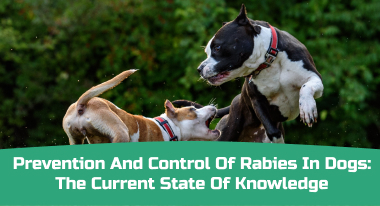Table of Contents
Have you ever noticed your furry friend showing joint discomfort or reduced mobility? Have they been experiencing stiffness, difficulty getting up, or showing signs of distress during their walks?
Well, it is possible they may be experiencing or suffering osteoarthritis, a common condition that affects dogs’ joints. Just like humans, our canine companions are susceptible to osteoarthritis, and we, as pet parents, must grasp this condition well.
By understanding its causes, recognizing the symptoms, and implementing effective management strategies, we can help improve their quality of life.
Osteoarthritis affects around 20% of dogs during their lifetime. [Source]
This prevalent condition can occur as a dog ages or due to genetics, obesity, previous joint injuries, or underlying conditions.
Large dog breeds are known to be more susceptible to osteoarthritis because of the extra stress placed on their joints.
So, let’s dive in and learn how to support your four-legged friend through their osteoarthritis journey!
What are the Causes of Osteoarthritis in Dogs?
Various factors, including aging-related joint strain and genetics, can cause dog osteoarthritis. This condition can also be exacerbated by obesity and prior joint traumas.
The infographic below represents the common causes of osteoarthritis in dogs:

Osteoarthritis (OA) is the leading cause of chronic pain in dogs, affecting 80% of dogs over 8 years old and potentially up to 35% of dogs of all ages. Let’s explore the underlying factors that contribute to the development of osteoarthritis in dogs. 1. Age & Onset of Osteoarthritis: Osteoarthritis is more common in older dogs, typically affecting those over the age of 7. The wear and tear on joints over time contributes to the development of arthritis. 2. Breed Predisposition Large dog breeds are more prone to developing osteoarthritis. Breeds such as Labrador Retrievers, German Shepherds, and Golden Retrievers are commonly affected. 3. Obesity Excess weight stresses the joints, leading to increased wear and tear. Overweight or obese dogs have a higher risk of developing osteoarthritis. 4. Joint Abnormalities Previous joint injuries, fractures, or developmental abnormalities can increase the likelihood of osteoarthritis. Poor joint conformation or improper alignment may contribute to joint degeneration. 5. Genetic Factors Some dogs may have a genetic predisposition to osteoarthritis. Inherited conditions such as hip or elbow dysplasia can lead to joint deterioration. 6. Joint Infections or Joint Stress Infections like Lyme disease or certain immune-mediated diseases can damage joints and lead to osteoarthritis. Repetitive activities or excessive exercise can strain the joints, causing cartilage breakdown and arthritis. |
Identifying Osteoarthritis in Dogs: Symptoms and Diagnosis
Familiarizing yourself with the symptoms and diagnosis of osteoarthritis in dogs is crucial for early diagnosis.
According to a study published in the Journal of the American Veterinary Medical Association, osteoarthritis is common in dogs – 20% of dogs less than 1 year of age, and 90% of dogs less than 5 years of age exhibiting signs of the condition [Source].
You should keep an eye out for signs:
- Lameness: Early diagnosis allows for timely intervention.
- Stiffness: A veterinary examination ensures an accurate diagnosis of your dog’s condition, which is essential for choosing the best course of therapy.
- Difficulty Moving or Reduces Mobility: Early diagnosis of osteoarthritis helps prevent additional joint degeneration and provides doors for treatments to enhance your dog’s quality of life.
- Behavioral changes (Increased irritability or decreased activity): A prompt veterinary examination allows the identification of any underlying factors causing behavioral changes and ensures that your dog receives proper care and management strategies.
If you notice any of these signs, seeking veterinary evaluation is essential. Early diagnosis allows for timely intervention to:
- Alleviate pain
- Manage the condition effectively
- Improve their overall comfort
To diagnose the symptoms of osteoarthritis in dogs, during the veterinary evaluation, your vet will conduct a thorough examination of your dog’s joints, assess their range of motion, and could potentially ask for some tests such as X-rays.
- Blood tests may be performed by a vet to rule out other conditions that can mimic or contribute to joint problems, such as Lyme disease or immune-mediated disorders.
- Veterinarians may manually examine the affected joint(s) to assess for pain, swelling, crepitus (grating sensation), or joint instability.
- In some cases, advanced imaging techniques like CT scans and MRI may be used to evaluate joint structures in more detail and assess the extent of joint damage.
However, note that no single test can definitively diagnose osteoarthritis. The diagnosis is typically made based on a combination of clinical signs, physical examination findings, and the results of diagnostic tests.These evaluations provide valuable information about the extent of joint damage and help determine the most suitable treatment options for your furry friend.
Effective Treatment Strategies for Osteoarthritis in Dogs
| – Exercise and Physical Therapy: Include routine, low-impact activities specific to your dog’s requirements, such as leash walks, swimming, and controlled play sessions. |
| – Weight Management: Maintain a healthy weight for your dog through a balanced diet and portion control. Some tips that you can follow are: Choose high-quality foodAvoid free-feedingUse smaller plates or puzzle feedersMonitor treats Measure meals |
| – Joint Supplements: Visit the veterinarian to determine suitable joint supplements containing ingredients like glucosamine and chondroitin. |
| – Pain Management Medications: Follow your vet’s guidance on prescribed pain medications or non-steroidal anti-inflammatory drugs (NSAIDs) to alleviate discomfort. |
| – Alternative Therapies: Consider alternative therapies like acupuncture or hydrotherapy under the guidance of a qualified professional. |
You should remember that these management strategies aren’t a one-size-fits-all solution. Visiting the vet and determining the best approach for your dog’s condition is essential.
By working together, you can develop a comprehensive plan that meets their needs and improves their overall quality of life. Your vet is your partner in this journey, and their expertise will guide you in making the right choices for your furry friend.
So, don’t hesitate to reach out and collaborate with your veterinarian for the well-being of your beloved companion! The main goal is to improve your furry friend’s quality of life, and there are several ways you can achieve it.
Enhancing Quality of Life
- Giving dogs with osteoarthritis a suitable living space is vital for enhancing their quality of life.
- Make minor adjustments to their daily routines, such as providing them with soft beds, non-slip surfaces, and ramps to avoid stairs.
- Consider changing their diet to include products that benefit joint health.
- Engage their minds with mentally challenging activities like puzzles or obedience training.
- Show them love, care, and connection to promote their emotional well-being.
- Create a cheerful, stress-free atmosphere to improve their comfort and happiness.
Conclusion
So there you have it!
When it comes to managing osteoarthritis, it’s all about finding what works best for your furry friend.
It’s a team effort between you and your vet. Stay in touch, keep them informed, and work together to tailor a plan that suits your dog’s needs.
With the right approach, you can make a real difference in their life, helping them stay happy, comfortable, and loved despite osteoarthritis.
Make the best choice for a better life for your furry friend!
Disclaimer: The content on the site is for educational purposes only, and it does not provide medical advice. The shared information must not be treated as a substitute for or alternative for medical practitioner advice, diagnosis, or treatment. Regarding any concerns about your pet’s health, seeking veterinary guidance is of utmost necessity. Each pet has specific health, fitness & nutrition needs. Do not disregard, avoid or delay pet health-related advice from veterinarians based on reading the information provided on this site.
FAQs:
- Can osteoarthritis in dogs be cured?
Osteoarthritis in dogs can’t be reversed or completely cured. However, there are effective treatments available that can significantly improve your furry friend’s condition. The primary goal of treatment is to alleviate the pain associated with the affected joints, while also slowing down the ongoing degeneration process. By doing so, you can help your dog lead a more comfortable life and continue to enjoy a quality of life as they age gracefully.
- Should I consult a veterinarian for my dog’s osteoarthritis?
It is recommended to consult a veterinarian if you suspect your dog has osteoarthritis. They have the expertise to diagnose the condition and develop a tailored treatment plan.
- Are there any home remedies or natural treatments for dog osteoarthritis?
While there are no “cure-all” home remedies or natural treatments for dog osteoarthritis, you can take some supportive measures such as:
- Providing a comfortable living environment,
- Incorporating joint-friendly supplements,
- Using therapies like heat or cold medicine to alleviate discomfort.
- Can exercise help dogs with osteoarthritis?
Yes, exercise can be highly beneficial for dogs with osteoarthritis. Low-impact activities like leash walks, swimming, and controlled play sessions help keep their joints mobile, strengthen muscles, and maintain a healthy weight. You should develop a suitable exercise plan that promotes joint health.
- Is weight management important for dogs with osteoarthritis?
Yes, weight management plays a crucial role in managing osteoarthritis in dogs. To help your furry friend, it’s important to focus on maintaining a healthy weight through a balanced diet. Providing them with nutritious meals and appropriate portions can make a big difference in reducing strain on the joints and improving mobility.



